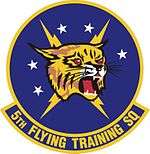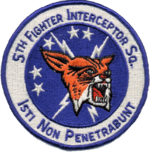5th Flying Training Squadron
| 5th Flying Training Squadron | |
|---|---|
|
5th Flying Training Squadron T-1 Jayhawk | |
| Active |
1941–1945; 1946–1988; 1990–1991; 1997–Present |
| Country |
|
| Branch |
|
| Role | Pilot Training |
| Part of | 340th Flying Training Group |
| Garrison/HQ | Vance Air Force Base, Oklahoma |
| Nickname(s) | Spittin' Kittens |
| Motto | Isti Non PenetrabuntLatin They Shall not Penetrate |
| Engagements |
|
| Decorations |
|
| Commanders | |
| Notable commanders | Jacksel M. Broughton |
| Insignia | |
| 5th Flying Training Squadron emblem (approved 16 January 1951)[1][2] |
 |
The 5th Flying Training Squadron (5 FTS) is part of the United States Air Force 71st Flying Training Wing based at Vance Air Force Base, Oklahoma. It operates the T-1 Jayhawk, T-38B Talon, and T-6A Texan II aircraft conducting flight training in support of the 71st Operations Group.
History
World War II
It was established as an Army Air Corps fighter squadron in January 1941. It was assigned to the Northeast Air District with P-40s and P-39s as part of the defense buildup prior to the United States entry into World War II.
It was deployed to the European Theater of Operations (ETO), assigned to VIII Fighter Command in August 1942. Its P-39 Airacobras were deemed unsuitable for the environment for escort duty. It was re-equipped with Supermarine Spitfires and was trained by the Royal Air Force. It flew some escort missions with VIII Bomber Command B-17 Flying Fortresses and B-24 Liberators during the fall of 1942.
It was sent to North Africa in late 1942 as part of the Operation Torch invasion forces, and took up station in Algeria. It was reassigned to Twelfth Air Force and flew both fighter escort missions for the B-17 Flying Fortresses operating from Algeria and tactical interdiction strikes on enemy targets of opportunity in Algeria and Tunisia during the North African Campaign.
Following the German defeat and withdrawal from North Africa the squadron participated in the Allied Invasion of Sicily and Invasion of Italy and subsequent drive of the United States Fifth Army up the Italian Peninsula. Engaged primarily in tactical operations after November 1943, supporting ground forces and attacking enemy targets of opportunity such as railroads, road convoys, bridges, strafing enemy airfields and other targets. It was deployed to Corsica in 1944 to attack enemy targets in support of Free French forces in the liberation of the island and to support Allied Forces in the invasion of Southern France. It continued offensive operations until the German capitulation in May 1945. It returned to the United States and was demobilized during the summer and fall 1945 and inactivated.
Air Defense Command

It was weactivated in 1946 as a United States Air Forces in Europe fighter squadron. It was primarily an occupation unit at Schweinfurt and Bad Kissingen Airfields. It was reassigned from USAFE to Air Defense Command in June 1947, equipped with P-61 Black Widows, and assigned to Mitchel Field, New York, to perform air defense of the eastern United States.
In June 1948 the unit transitioned into F-82 Twin Mustangs. In the fall of 1949 the unit moved to McGuire AFB, New Jersey. In August 1955 the 5th FIS designation was transferred to Suffolk County AFB, New York. In the spring of 1957 the unit transitioned into F-102A Delta Daggers.
In February 1960 the 5th FIS moved to Minot Air Force Base, North Dakota, and transitioned into the F-106 Delta Dart under the 32d Fighter Wing.[3] Although the number of ADC interceptor squadrons remained almost constant in the early 1960s, attrition (and the fact that production lines closed in 1961) caused a gradual drop in the number of planes assigned to typical fighter squadrons, from 24 to typically 18 by 1964 and 12 by 1967. These reductions resulted in the squadron's parent 32d Fighter Wing's inactivation and the transfer of Minot to Strategic Air Command in July 1962.[3][4]
On 22 October 1962, before President John F. Kennedy told Americans that missiles were in place in Cuba, the squadron dispersed one third of its force, equipped with nuclear tipped missiles to Hector Field at the start of the Cuban Missile Crisis.[5][6] These planes returned to Minot after the crisis. In late 1962 the 5th FIS acquired two live lynx kittens ("Spitten" and "Kitten") as mascots, with the assistance of the Minot Daily News, after a farmer had killed their mother.[7][8]
In the mid-1980s the 5th FIS converted to the F-15 Eagles. The F-15s only flew over Minot until the spring of 1988, when the 5th FIS was inactivated. The lynx den in the squadron was one of the few places where Canada lynx had bred in captivity in the U.S.,[8] prompting both the St. Louis and San Diego Zoos to copy it in an attempt to get their own lynx inhabitants to produce offspring. Several generations of lynx flourished there, and after the unit was inactivated, Delta and Dart, twin kitten descendants of the original two Lynx kitten mascots were donated to the Roosevelt Park Zoo in Minot.
As an Air Defense Command unit, the squadron's motto was Isti Non Penetrabunt, literally "they shall not penetrate", but colloquially to crews as The Bastards Shall Not Pass.[9]
Modern era
It was reactivated in 1990 as an Air Training Command (later AETC) Undergraduate Pilot Training squadron at Vance AFB. The squadron had trained pilots and pilot instructors from February 1990 to December 1991 and since 1997.[10]
Lineage

- Constituted as the 5th Pursuit Squadron (Interceptor) on 20 November 1940
- Activated on 15 January 1941
- Re-designated 5th Fighter Squadron on 15 May 1942
- Inactivated on 7 November 1945
- Activated on 9 November 1946
- Re-designated 5th Fighter Squadron, All Weather on 10 May 1948
- Re-designated 5th Fighter-All Weather Squadron on 20 January 1950
- Re-designated 5th Fighter-Interceptor Squadron on 1 May 1951
- Inactivated on 1 July 1988
- Re-designated 5th Flying Training Squadron on 1 January 1990
- Activated on 16 February 1990
- Inactivated on 15 December 1991
- Re-designated 5th Flying Training Flight and activated in the Reserve on 1 April 1997
- Re-designated 5th Flying Training Squadron on 1 April 1998[10]
Assignments
|
|
Stations
- Selfridge Field, Michigan. 15 January 1941
- Floyd Bennett Airport, New York, 17 December 1941
- Selfridge Field, Michigan, 14 January 1942
- Florence, South Carolina, 18 February 1942
- Wilmington, North Carolina, 27 April 1942
- Grenier Field, New Hampshire, 12 June 1942 - 19 July 1942
- Northern Ireland, 19 August 1942
- RAF Goxhill, England, 26 August 1942 - 27 October 1942
- Tafaraoui, Algeria, 8 November 1942 (air echelon only)
- La Senia Airfield, Oran, Algeria, 12 November 1942
- Orleansville Airfield, Algeria, 1 January 1943
- Telergma Airfield, Algeria, 19 January 1943
- Youks-les-Bains Airfield, Algeria, 8 March 1943
- Le Sers Airfield, Tunisia, 12 April 1943
- La Sebala Airfield, Tunisia, 20 May 1943
- Bo Rizzo, Sicily, Italy, 1 August 1943
- Borgo, Corsica, 1 December 1943
- Madna Airfield, Italy, 14 May 1944
- Piagiolino Airfield, Italy, c. 24 April 1945
- Lesina Airfield, Italy, c. 10 July 1945 - August 1945
- Drew Field, Florida, 25 August 1945 - 7 November 1945
- Schweinfurt, Germany, 9 Nov 1946
- Bad Kissingen, Germany, 5 May 1947
- Mitchel Field (later Mitchel Air Force Base), New York, 25 Jun 1947
- McGuire Air Force Base, New Jersey, 4 October 1949
- Suffolk County Air Force Base, New York, 18 August 1955
- Minot Air Force Base, North Dakota, 1 February 1960 - 1 July 1988
- Vance Air Force Base, Oklahoma, 16 February 1990 - 15 December 1991
- Vance Air Force Base, Oklahoma, 1 April 1997 – Present[10]
Aircraft
- P-40 Warhawk (1941–1942)
- P-39 Airacobra (1942)
- Supermarine Spitfire (1942–1944)
- P-51 Mustang (1944–1945)
- P-61 Black Widow (1947–1948)
- F-82 Twin Mustang (1948–1951)
- F-94A Starfire (1951–1953)
- F-86D Sabre Interceptor (1953–1956)
- F-102 Delta Dagger (1956–1960)
- Convair F-106 Delta Dart (1960–1985)
- F-15 Eagle (1984–1988)
- T-37 Tweet (1990–1991, 1998–2006)
- T-38 Talon (1990–1991, 1998–Present)
- T-1 Jayhawk (1998–Present)[10]
See also
| Wikimedia Commons has media related to 5th Flying Training Squadron. |
| Wikimedia Commons has media related to 5th Fighter-All Weather Squadron. |
References
Notes
![]() This article incorporates public domain material from websites or documents of the Air Force Historical Research Agency.
This article incorporates public domain material from websites or documents of the Air Force Historical Research Agency.
- ↑ Maurer, Maurer, ed. (1982) [1969]. Combat Squadrons of the Air Force, World War II (PDF) (reprint ed.). Washington, DC: Office of Air Force History. pp. 34–35. ISBN 0-405-12194-6. LCCN 70605402. OCLC 72556.
- ↑ This emblem was modified to bring the lightning bolts within the disc
- 1 2 Ravenstein, Charles A. (1984). Air Force Combat Wings, Lineage & Honors Histories 1947-1977 (PDF). Washington, DC: Office of Air Force History. pp. 57–58. ISBN 0-912799-12-9.
- ↑ McMullen, Richard F. (1964) "The Fighter Interceptor Force 1962-1964" ADC Historical Study No. 27, Air Defense Command, Ent Air Force Base, CO (Confidential, declassified 22 Mar 2000), pp. 41, 43-45
- ↑ McMullen, pp. 10-12
- ↑ NORAD/CONAD Participation in the Cuban Missile Crisis, Historical Reference Paper No. 8, Directorate of Command History Continental Air Defense Command, Ent AFB, CO , 1 Feb 63 (Top Secret NOFORN declassified 9 March 1996). p. 16
- ↑ Broughton, Jack (2007). Rupert Red Two: A Fighter Pilot's Life from Thunderbolts to Thunderchiefs, Zenith Press, ISBN 978-0-7603-3217-7, pp. 276–278
- 1 2 "Spittin' Kitten family expands". Spokesman-Review (Spokane, Washington). Associated Press. May 26, 1970. p. 13.
- ↑ Broughton 2007, p. 274
- 1 2 3 4 5 Haulman, Daniel L. (January 8, 2008). "Factsheet 31 Fighter Wing (USAFE)". Air Force Historical Research Agency.
Bibliography
- Broughton, Jack (2007). Rupert Red Two: A Fighter Pilot's Life from Thunderbolts to Thunderchiefs, Zenith Press, ISBN 978-0-7603-3217-7, pp. 276–278
- Cornett, Lloyd H.; Johnson, Mildred W. (1980). A Handbook of Aerospace Defense Organization, 1946–1980 (PDF). Peterson AFB, CO: Office of History, Aerospace Defense Center.
- Maurer, Maurer, ed. (1982) [1969]. Combat Squadrons of the Air Force, World War II (PDF) (reprint ed.). Washington, DC: Office of Air Force History. ISBN 0-405-12194-6. LCCN 70605402. OCLC 72556.
- McMullen, Richard F. (1964) "The Fighter Interceptor Force 1962-1964" ADC Historical Study No. 27, Air Defense Command, Ent Air Force Base, CO (Confidential, declassified 22 Mar 2000)
- NORAD/CONAD Participation in the Cuban Missile Crisis, Historical Reference Paper No. 8, Directorate of Command History Continental Air Defense Command, Ent AFB, CO, 1 Feb 63 (Top Secret NOFORN declassified 9 March 1996)
External links
| ||||||||||||||||||||||||||||||||||
| |||||||||||||||||||||||||||||||||||||||||||||||



